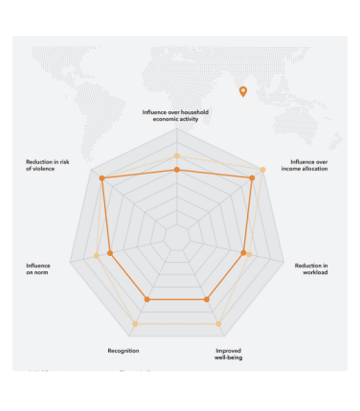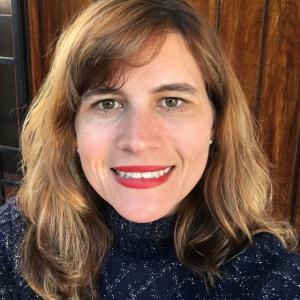What Can We Learn From a Flagship Market Systems Development Program When it Comes to Achieving More Equitable Impact?
Blog #3: In Search of More Equitable Impact
What can we learn from the Market Development Facility (MDF), a program with more than a decade of insights from implementation in eight countries across the Asia-Pacific region? I went straight to the source, Ajla Vilogorac who is the Director of Research, Impact Measurement and Inclusion at Market Development Facility (MDF) to hear about three ways she is authentically mainstreaming GEDSI across the program and creating more equitable impact.
Write inclusion into the job (title and responsibilities).
In the realm of development, inclusion often takes a backseat in both job titles and responsibilities, according to Ajla. So, in 2018, MDF renamed their Results Measurement (Monitoring and Evaluation) unit to Quality and Inclusion Unit (Q&I)[1] and re-titled positions to place a stronger emphasis on inclusion.
“We wanted to feature ‘inclusion’ in the title because we’ve always felt that being inclusive is the only way to work in the Asia-Pacific. Additionally, we wanted to ensure that the key functions the Unit performs are reflected in the title. Beyond the traditional results measurement (monitoring and evaluation), our teams lead on research, assessing the impact and understanding how it all comes together: we wanted to ensure it's evidence based, and it has gone through a process of triangulation before we report results.”
With this title change, Ajla and her colleagues wanted to show that the Unit doesn’t chase numbers but rather wants to dig into the stories behind those numbers. To this end, they try to detect patterns and trends across the portfolio of program investments, with a specific lens on how those investments have impacted women and other disadvantaged groups. This means paying attention to both the quantitative and qualitative data. According to Ajla, the team has seen several cases where women have benefitted in non-economic ways. These findings would have been lost if the team didn’t combine quantitative and qualitative data collection methods. For example, in the sugar sector, women report substantial benefits from the innovation introduced by MDF that pushed their start time for work from 4am to 8am. Women interviewed by MDF say that this newfound time freedom has meant more to them than any new income.
 Visualize the change you want to see.
Visualize the change you want to see.
“We really couldn't get our heads around what constitutes transformative change”, Ajla said. So, she and her team developed a tool to visualize and track changes to women’s economic empowerment (WEE). The innovative spider graph, featured in this report and this report, measures access and agency in two different ways: access in terms of provision of goods and services to women directly by the program and also indirect impact on their agency through workload management and household and community recognition. This graphic representation of WEE, gave the team new insights. For example, Ajla realized that in the Asia-Pacific, recognition in community often means more for women than actual economic advancement.
The spider graph tool, which graphically represents quantitative data, also helped Ajla and her team make a stronger case for WEE among colleagues and peers within the MSD community, which often privileges quantitative over qualitative data.
“I'm a numbers person by birth. I'm not saying that we should neglect approaches to capturing the numbers, but I think more emphasis should be given to telling the story behind the numbers, and that the spider graph is the best tool we have to do it.”
Tailor tools to capture nuances around inclusion in your specific context.
MDF currently operates in six countries across Asia and the Pacific. While the MDF team intuitively knew that inclusion and even WEE, would differ in each country, it has taken time to develop and trial the tools to better understand which groups are excluded and why in each context. For example, in Sri Lanka, economically disadvantaged groups from the North are of interest to the program, while in certain Pacific countries, rural populations are the target community.
The introduction of a ‘Concept Note’ early in the design process helps staff focus attention on inclusion and its specifics in their given context. The Concept Note, which is jointly developed by the intervention teams and the Q&I unit, has specific questions related to inclusion and the impacts (tangible and intangible) on target groups but also requires the author to connect their contextual understanding to wider system changes as well to the specific activities, budgets, and value for money.
Emphasize the how as much as the what.
While the Concept Note tool (Box 1) puts the topic of inclusion front and center at MDF, Ajla acknowledges that all tools have limitations if the team isn’t fully engaged.
“It's not just the tools we use, it is how we approach the research that makes the difference.”
Box 1: MDF Concept Note & Inclusion
The Concept Note explains the context, constraints, and opportunities of the proposed intervention, as well as the partners that are uniquely positioned to drive the change and planned activities. It assesses how does the intervention address inclusion, by assessing:
The beneficiary profile, what changes (behavior, price, productivity, access, voice, etc.) are we expecting to see in the target beneficiaries, the projected income they will generate and relevance of the results to the country context.
Barriers for women in the market system, opportunities to address them, the constraints women face and the capacities of the organization/partner in addressing them.
Other forms of inclusion, such as disability, ethnicity, and nutrition.
MDF’s leadership agrees with Ajla on this point, and the project invests in staff training and coaching in WEE and Social Inclusion. Ajla takes things further; when she sees staff show an interest in inclusion, she delegates additional responsibilities to them. This may involve asking them to review the inclusion part of the Concept Note or conduct research to assess roles of women in the community and/or households or assess the impact that the intervention has had on women. By making inclusion part of how MDF does business through tools, training, and topical discussions, Ajla is seeing GEDSI being authentically mainstreamed across the program.
—------------------------
The Market Development Facility (MDF) is a multi-country initiative which promotes sustainable economic development through higher incomes for women and men in our partner countries. We support business and government partners to identify and grow commercial opportunities that are profitable, scalable and deliver lasting social and environmental value. This enhances investment and coordination and allows partnerships to flourish, strengthening inclusive economic growth. MDF is funded by the Australian Government and the New Zealand Government. It is implemented by Palladium in partnership with Swisscontact. MDF currently operates in Fiji, Timor-Leste, Sri Lanka, Samoa, Tonga, and Vanuatu.
This blog series is written by the Canopy Lab’s Managing Partner and Inclusion+ Practice Lead Holly Lard Krueger, with support from Research and Business Development Intern, Audrey Lodes. The Canopy Lab is a Washington, DC based consulting firm specialized in the practical application of systems thinking.
[1] As of September 2023, the MDF’s unit name is “Research, Impact Measurement and Research” unit.


